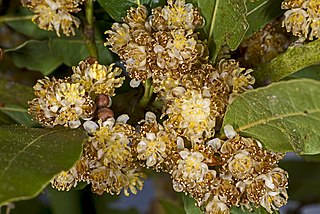
The Laurales are an order of flowering plants. They are magnoliids, related to the Magnoliales.
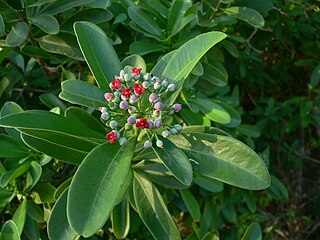
Canellales is the botanical name for an order of flowering plants, one of the four orders of the magnoliids. It is recognized by the most recent classification of flowering plants, the APG IV system. It is defined to contain two families: Canellaceae and Winteraceae, which comprise 136 species of fragrant trees and shrubs. The Canellaceae are found in tropical America and Africa, and the Winteraceae are part of the Antarctic flora. Although the order was defined based on phylogenetic studies, a number of possible synapomorphies have been suggested, relating to the pollen tube, the seeds, the thickness of the integument, and other aspects of the morphology.
Hamamelidales is an order of flowering plants formerly accepted in a number of systems of plant taxonomy, including the Cronquist system published in 1968 and 1988. The order is not currently accepted in the Angiosperm Phylogeny Group III system of plant taxonomy, the most widely accepted system as molecular systematic studies have suggested that these families are not closely related to each other. The APG II system (2003) assigns them to several different orders: Hamamelidaceae and Cercidiphyllaceae to Saxifragales, Eupteleaceae to Ranunculales, Platanaceae to Proteales, and Myrothamnaceae to Gunnerales. Additional studies of the chloroplast genome have since confirmed that the families moved into the Saxigragales are closely related.

The Aquifoliales are an order of flowering plants, including the Aquifoliaceae (holly) family, and also the Helwingiaceae and the Phyllonomaceae. In 2001, the families Stemonuraceae and Cardiopteridaceae were added to this order. This circumscription of Aquifoliales was recognized by the Angiosperm Phylogeny Group when they published the APG II system in 2003. In the Cronquist system, there is no Aquifoliales order: the Aquifoliaceae are placed within the order Celastrales and the others are in other families.

The Zygophyllales are an order of dicotyledonous plants, comprising the following two families:
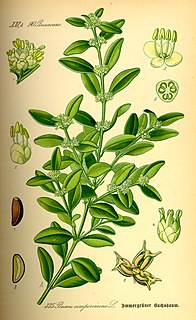
The Buxales are a small order of eudicot flowering plants, recognized by the APG IV system of 2016. The order includes the family Buxaceae; the families Didymelaceae and Haptanthaceae may also be recognized or may be included in the Buxaceae. Many members of the order are evergreen shrubs or trees, although some are herbaceous perennials. They have separate "male" (staminate) and "female" (carpellate) flowers, mostly on the same plant. Some species are of economic importance either for the wood they produce or as ornamental plants.

The Angiosperm Phylogeny Group, or APG, is an informal international group of systematic botanists who collaborate to establish a consensus on the taxonomy of flowering plants (angiosperms) that reflects new knowledge about plant relationships discovered through phylogenetic studies.

In the APG IV system (2016) for the classification of flowering plants, the name asterids denotes a clade. Common examples include the common daisy, the forget-me-nots, nightshades, the common sunflower, petunias, yacon, morning glory, sweet potato, coffee, lavender, lilac, olive, jasmine, honeysuckle, ash tree, teak, snapdragon, sesame, psyllium, garden sage, table herbs such as mint, basil, and rosemary, and rainforest trees such as Brazil nut.
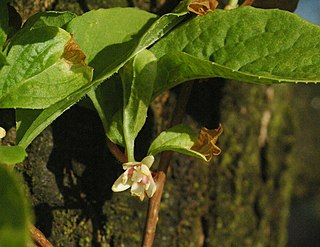
Schisandraceae is a family of flowering plants with 3 known genera and a total of 92 known species. Such a family has been recognized by most taxonomists, at least for the past several decades. Before that, the plants concerned were assigned to family Magnoliaceae and Illiciaceae.

Myrothamnus is a genus of flowering plants, consisting of two species of small xerophytic shrubs, in the southern parts of tropical Africa and in Madagascar. Myrothamnus is recognized as the only genus in the family Myrothamnaceae.
The APG II system of plant classification is the second, now obsolete, version of a modern, mostly molecular-based, system of plant taxonomy that was published in April 2003 by the Angiosperm Phylogeny Group. It was a revision of the first APG system, published in 1998, and was superseded in 2009 by a further revision, the APG III system.

In plant taxonomy, commelinids is a clade of flowering plants within the monocots, distinguished by having cell walls containing ferulic acid.
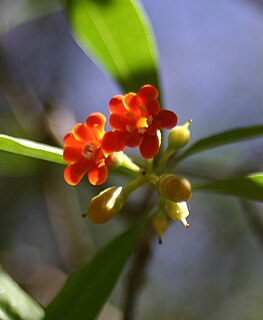
Theophrastoideae is a small subfamily of flowering plants in the family Primulaceae. It was formerly recognized as a separate family Theophrastaceae. As previously circumscribed, the family consisted of seven genera and 95 species of trees or shrubs, native to tropical regions of the Americas.

Staphyleaceae is a small family of flowering plants in the order Crossosomatales, native to Europe, temperate and tropical Asia and the Americas. The largest genus Staphylea, which gives the family its name, contains the "bladdernut" trees. The family includes three genera with more than 40 known species.

Aphloia is a genus of flowering plants that contains a single species, Aphloia theiformis, the sole species of the monogeneric family Aphloiaceae. It is a species of evergreen shrubs or small trees occurring in East Africa, Madagascar, the Mascarene Islands and the Seychelles.
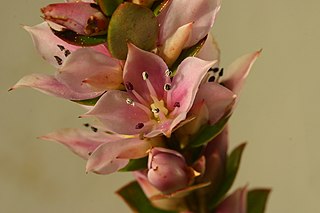
Geissoloma is a genus of flowering plants in the monotypic family Geissolomataceae, native to the Cape Province of South Africa. The plants are xerophytic evergreen shrubs and are known to accumulate aluminum. It is sometimes called guyalone in English.
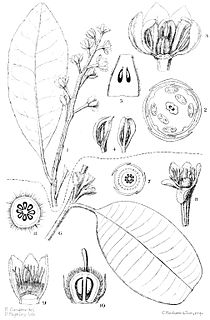
Sphenostemon is the genus of small evergreen trees or shrubs native to New Guinea, Queensland (Australia) and New Caledonia. They have opposite or spiral leaves, and at most small stipules. The small flowers, borne in terminal inflorescences, have free sepals and petals. The anthers have thick filaments. The fruit, a berry, is fleshy and contains two seeds. The genus is described as "particularly poorly known".
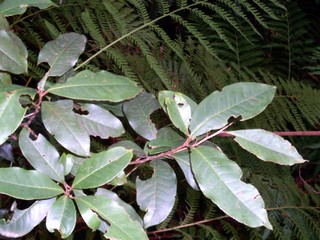
The Paracryphiaceae are a family of woody shrubs and trees native to Australia, southeast Asia, and New Caledonia. In the APG III system of 2009, the family is placed in its own order, Paracryphiales, in the campanulid clade of the asterids. In the earlier APG II system, the family was unplaced as to order and included only Paracryphia.
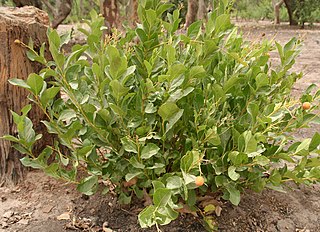
Icacinales is an order of Angiosperms.
PtaeroxylaceaeJuss. are a small family of Southern African indigenous trees and woody lianes, most of them from Madagascar, comprising only two genera. Such a family was not recognized by the APG II system of classification (2003), which noted that it was a synonym of Rutaceae. The APG III system of 2009, an updated version of the last system, did not mention the family. All species within this family are included within Rutaceae.

















